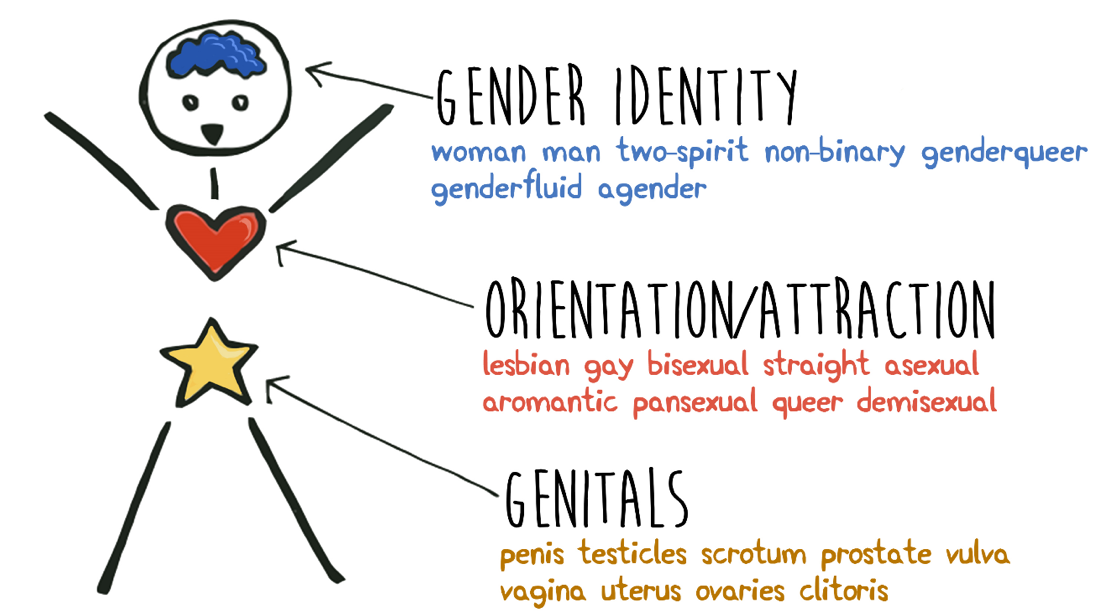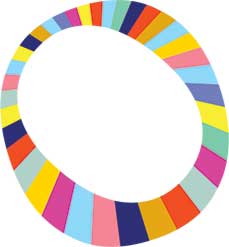Aromantic: A name for a type of sexual orientation. Commonly used as a specific identity term by someone (cisgender or transgender) who experiences no romantic attraction. People who identify as aromantic may experience sexual attraction and friendship connections, but they may not be interested in romantic relationships. Commonly abbreviated to ‘aro’. Aromantic also describes someone whose experience of romance is not based on what society thinks people ought to do. A person who is aromantic may be repulsed by romance, or simply uninterested in romantic relationships.
Asexual: People (cisgender or transgender) who do not experience sexual attraction. Commonly shortened to ace. Asexual is a name for a type of sexual orientation or the absence of one. Asexual people are attracted to others on many layers such as romantic attraction, wanting to be close and to love, and platonically the way we love friends. An asexual person may be attracted to people on a romantic level. They may want to hold hands, kiss, and even get married, but they are not interested in the sexual parts of that relationship. However, they still might engage in masturbation or sexual activity with another person for various reasons.
Bisexual: A name for a type of sexual orientation. People (cisgender or transgender) who are attracted to people of their own gender and to genders different from their own. Commonly shortened to bi.
Cisgender: A term to describe a person whose sex assigned at birth and felt sense of gender identity are aligned. Can be shortened to cis. For example, someone with a penis who was assigned male at birth and who identifies as a male could be called a cis man. Someone with a vulva who was assigned female at birth and who identifies as female could be called a cis woman.
Gay: Someone (cisgender or transgender) who is primarily attracted to people of the same gender. Can be used for any gender, but is most often used for men who are attracted to men.
Gender: A person’s gender is the complex interrelationship between three dimensions: body, identity, and social gender. Body: our body, our experience of our own body, how society genders bodies, and how others interact with us based on our body. Identity: the name we use to convey our gender based on our deeply held, internal sense of self. Identities typically fall into binary (e.g. man, woman) nonbinary (e.g., genderqueer, genderfluid, etc) or ungendered (e.g., agender, genderless) categories. The meaning associated with a particular identity can vary among individuals using the same term. A person’s gender identity can correspond to or differ from the sex they were assigned at birth. Social gender: how we present our gender in the world and how individuals, society, culture, and community perceive, interact with, and try to shape our gender. Social gender includes gender roles and expectations and how society uses those to try to enforce conformity to current gender norms.
Gender Expression: How a person publicly presents their gender. This can include behaviour and outward appearance, such as how someone dresses, how they wear their hair, whether they use make-up, their body language, and their voice.
Gender Fluid: A term used to describe someone who moves between binary constructions of gender, and whose gender identity and expressions vary over time.
Gender Identity: A label used to describe a person’s own internal sense and understanding of their gender. It is not detectable by others. Gender identities we commonly hear include man/boy, woman/girl, and non-binary. Common gender identities are defined by, and may be unique to, a certain culture or place. For example, Hijra is a term to describe a third gender in India.
Intersex: An umbrella term to describe a person who is born with physical, hormonal, and/or genetic characteristics that do not fit into traditional boxes of male/boy or female/girl. For example, some intersex babies may be born with ambiguous genitalia that is not clearly a penis or a vulva. Up to 1.7% of the population is thought to be intersex. Sometimes surgery is performed on intersex infants and/or children without their consent to make them appear more typically male or female. The United Nations, Physicians for Human Rights, and Rights Watch consider such operations as violations of human rights. In Canada, there is a call to amend the criminal code that allows for cosmetic surgeries to “normalize” the appearance of genitals on intersex babies.
Non-Binary: A word to describe a person whose sexuality, gender identity, and/or gender expression falls outside of a traditional and rigid male/female division.
Pansexual: A name for a type of sexual orientation. Someone (cisgender or transgender) who is attracted to all genders and is specifically attracted based on personality.
Privilege: Privilege describes the benefits and opportunities that individuals and groups are afforded based on their identities including political, social, and economic power. Privilege is acquired without having to do something for it. It is created by our social structures and is unearned based on one’s social location. Privilege can be related to differing levels of knowledge, access to information, and visibility in social structures.
Pronouns: Pronouns are name replacements. Common gender pronouns include He/Him/His, She/Her/Hers, and They/Them/Their. However, there are many other pronouns that people use to communicate and affirm their identities. When speaking or referring to someone, pronouns can affirm their gender identity and/or expression. Using gender neutral pronouns helps us avoid assumptions about how people identify. We should only use gendered pronouns when we have been told by someone what their pronoun preferences are.
Queer: It is an umbrella term to describe sexual orientations and gender identities other than heterosexual and cisgender. Historically, the term queer was used in a derogatory and stigmatizing way and was intended to harm and hurt individuals belonging to the 2SLGBTQ+ community. However, in recent times the word queer has been reclaimed by people of diverse sexualities and gender identities and is used as a positive and powerful self-identifying term.
Sex: Refers to a set of biological attributes in humans and animals. It is primarily associated with physical and physiological features including chromosomes, gene expression, hormone levels and function, and reproductive/sexual anatomy.
Sexual Orientation: Describes the pattern of a person’s emotional, romantic, and/or sexual attraction, specifically the gender(s) of people they are attracted to in relation to their own. Words for different types of sexual orientations include gay, lesbian, bisexual, and straight/heterosexual (among many other terms)
Straight/Heterosexual: A name for a type of sexual orientation. People (cisgender or transgender) who are attracted to genders different from their own. Commonly shortened to hetero. It is most often used to describe women who are attracted to only or almost only men, and men who are attracted to only or almost only women.
Transgender: A name for a type of gender identity. The term describes a person whose sex assigned at birth is different from their felt sense of gender identity. It is often shortened to trans. For example, someone with a penis who was assigned male at birth but who identifies as a female could be called a transwoman or transfeminine. Someone with a vulva who was assigned female at birth but who identifies as male could be called a transman or transmasculine. Like all genders, transgender is determined by a person for themselves; it is not something they can be told they are by others.
Two Spirit: An Indigenous specific term referring to gender, sexual orientation, and spirituality. For some Indigenous people, this term may imply the embodiment of both masculine and feminine spiritual qualities within the same body. The word “Two Spirit” was created in the early 1990s, by a group of Two Spirit community members and leaders. Two Spirit is not used in all Indigenous communities and regions. It is important to understand that this term is used and described differently by each person and community and not all Indigenous people who hold diverse sexual and gender identities consider themselves Two Spirit, many identify themselves as LGBTQ+.


